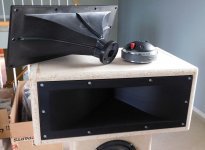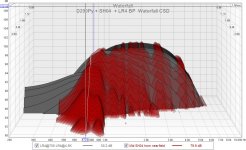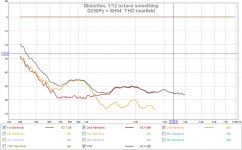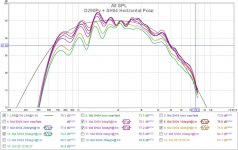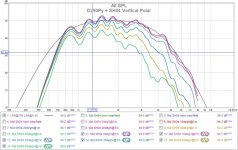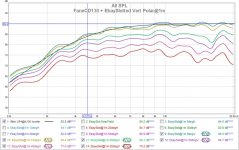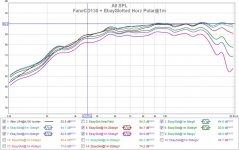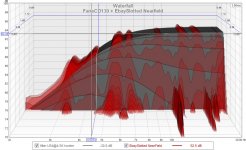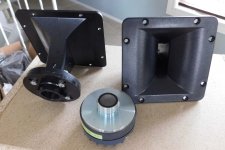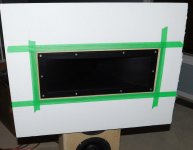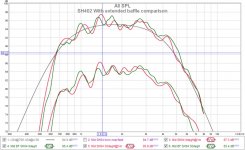MF horn tests - PRV D290py + B52 HS402
More horn measurements for comparison to the midranges I tested earlier.
The D290Py driver is advertised 650-19K and it can do that but at the low end it needed additional EQ to follow my LR4 curve and then it drops like a rock under 600Hz. Fortunately, this is sufficient for me to get a flattish system FR curve.
The waterfall CSD also shows some issues at the lower roll off. Not sure what is causing the longer settling time under 1KHz. The HS402 is suppose to be "like" the JBL2370 or Paudio PH2370 and should go low enough. You can also see the THD rise for f<1Khz so seems like the driver's limitation.
The SH402 is advertised as 90x40 and it does that, as shown in the horizontal and vertical polar curves. The measurements are 10deg step, indoors @1m, mid-horn vertical, and gated [-1,5ms].
More horn measurements for comparison to the midranges I tested earlier.
The D290Py driver is advertised 650-19K and it can do that but at the low end it needed additional EQ to follow my LR4 curve and then it drops like a rock under 600Hz. Fortunately, this is sufficient for me to get a flattish system FR curve.
The waterfall CSD also shows some issues at the lower roll off. Not sure what is causing the longer settling time under 1KHz. The HS402 is suppose to be "like" the JBL2370 or Paudio PH2370 and should go low enough. You can also see the THD rise for f<1Khz so seems like the driver's limitation.
The SH402 is advertised as 90x40 and it does that, as shown in the horizontal and vertical polar curves. The measurements are 10deg step, indoors @1m, mid-horn vertical, and gated [-1,5ms].
Attachments
Last edited:
HF horn tests - FaneCD130 + EbaySlotted
Another HF test using some random Ebay tweeter horns I bought, just for fun. I'm not sure if this is original or a design copy. These can be compared to earlier tweeter tests. It is much better than I was expecting, and I'm pleasantly surprised.
The waterfall CSD used a different Fane CD130 and it shows the same resonant points at [11.3Khz, 15.9Khz] so it's the driver causing them. I still don't notice those resonances. The ideal LR4 is shown as well for comparison.
The horizontal polar is surprisingly tight up to 15Khz. The vertical polar falls off nicely with angle, so there's less energy to the floor. The gray curve is the ideal LR4 at 0deg. All measurements were at 1m, in room with a rug, and gated [-1,3ms].
Another HF test using some random Ebay tweeter horns I bought, just for fun. I'm not sure if this is original or a design copy. These can be compared to earlier tweeter tests. It is much better than I was expecting, and I'm pleasantly surprised.
The waterfall CSD used a different Fane CD130 and it shows the same resonant points at [11.3Khz, 15.9Khz] so it's the driver causing them. I still don't notice those resonances. The ideal LR4 is shown as well for comparison.
The horizontal polar is surprisingly tight up to 15Khz. The vertical polar falls off nicely with angle, so there's less energy to the floor. The gray curve is the ideal LR4 at 0deg. All measurements were at 1m, in room with a rug, and gated [-1,3ms].
Attachments
Last edited:
Member
Joined 2009
Paid Member
The measurements are 10deg step, indoors @1m, mid-horn vertical, and gated [-1,5ms].
To much diffractive "ripple".
A thorough job - this is going in a nice direction
Thanks, hopefully when I'm finished I will not look down to see my own footprints. 🙂
To much diffractive "ripple".
I thought about that as well, but I'm not convinced yet.
The Dayton H07E has an elaborate curved surface so there should not be very much energy at the mouth edge. However notice how much smoother the FR is for the random ebay horn. They are both mounted in similar boxes.
Only the midrange horn has a small baffle with radius edge and it has more ripple at low frequency.
Only the midrange horn has a small baffle with radius edge and it has more ripple at low frequency.
-that's what I was *referring to. 😉
*or failing to do. 😱
a bit off topic but: @ Line Source. Could you show links to (third party) measurements of the Magico's?
Magico Q5 Loudspeaker (TAS 214)
"Indeed, when it comes to low noise, the combination of the Qs revised driver complement and its improved enclosure is impressive. Although I am unable to perform harmonic distortion measurements in an anechoic chamber (which is, of course, the right way to do it), I am now able to make rough THD measurements, thanks to new OmniMic software and hardware designed by my friend Bill Waslo (the author of the Liberty Instruments’ Praxis Suite program I use to take frequency response measurements and RTAs). Here is how the Q5s measured in my room, with the understanding that ambient noise was probably raising these THD curves several dB (see Harmonic Distortion chart).
Note that these measurements were taken at very loud levels (almost 90dB SPL), where most speakers do not fare as well as they do at lower volumes, and also note that, in Bill Waslo’s own words, they are “extraordinary.” Even at its highest (and this was probably skewed by traffic passing on the street outside my house), THD at nearly 90dB SPLs was below 1% and typically on the order of 0.4%! These are loudspeaker measurements, folks. Not a preamp.
The net result of this lower distortion is greatly improved low-level resolution at low volume levels and, consequently, greatly improved overall dynamic range. Where the M5 for all its many virtues was not the equal of a ’stat like the MartinLogan CLX at reproducing pianissimos, the Q5 very nearly is. And it is vastly superior to the Logans (and to planars) when it come to overall dynamic range—from going from very soft to very loud."
Attachments
Only the midrange horn has a small baffle with radius edge and it has more ripple at low frequency.
Looking at the measurements again, I'd be real tempted to do a bipole or dipole design with front and rear facing horns oriented VERTICALLY. (..though I'd probably keep something like the ebay slot-horn in it's normal horizontal position). With the more narrow profile for the horns: then make a large round-over (both (front) baffle and rear panel/baffle). With a crossover around 1.7 kHz or lower. Probably put the midbass array on the sides of the loudspeaker, and the treble horn(s) as an extension above the cabinet with adjustment for depth and "tilt" down to listener.
Last edited:
A test is coming. I'm curious now about whether the midrange horn is affected by baffle size.
Last edited:
-you might also try blocking-out (like a slightly/1-1/2" overlapping picture frame) the horn "mouth" with higher/smaller-pore ppi foam. (..say 40 ppi as a guess).
Here is the larger baffle experiment for the SH402 to see if it reduces ripple. The mic is not exactly in the same position so some of the bumps are shifted a little. The top set are 0deg with and without a larger baffle, and the deliberately lowered curve set are 30deg horizontals. They look about the same with and without a larger baffle.
I'm not too concerned with the ripples for now. They can be flattened with more EQ. I was looking at the horn's polar pattern and whether its consistent enough (no surprises) to work with.
Worth trying the baffle idea just to find out 🙂
@ScottG - I might try foam at some time later. I don't have any material like that except maybe some scrub pads.
I'm not too concerned with the ripples for now. They can be flattened with more EQ. I was looking at the horn's polar pattern and whether its consistent enough (no surprises) to work with.
Worth trying the baffle idea just to find out 🙂
@ScottG - I might try foam at some time later. I don't have any material like that except maybe some scrub pads.
Attachments
Last edited:
Context? Is that material used in clothing or a house ?
Added - I looked it up its a building product. I only have fibreglass and poly insulation.
Added - I looked it up its a building product. I only have fibreglass and poly insulation.
Last edited:
House:
UltraTouch™ Denim Insulation << Bonded Logic
excellent for acoustics, but it doesn't have enough "structure" when compared to rockwool.
YouTube
This is the 1.5 inch thick stuff I purchase for loudspeaker projects:
https://www.homedepot.com/p/UltraTo...ERCH=REC-_-pipsem-_-202709974-_-202710055-_-N
UltraTouch™ Denim Insulation << Bonded Logic
excellent for acoustics, but it doesn't have enough "structure" when compared to rockwool.
YouTube
This is the 1.5 inch thick stuff I purchase for loudspeaker projects:
https://www.homedepot.com/p/UltraTo...ERCH=REC-_-pipsem-_-202709974-_-202710055-_-N
Last edited:
I'm thinking the ripples are inherent in this horn. It would not be difficult for me to create an ABEC model and see if the sim behaves the same.
I am getting similar ripple on my ARB2 (2380 clone) with JBL2445 - I do not have polars for it yet, but you saw my measurements with the CP385 and an adapter.
Yes, your ARB2 does have ripple as well but its the trench around 2.6Khz that is a concern. I think its too wide and deep to be ripple. That's why I suspected there is another issue at play.
My ebay slotted horn and ebay adapter required a gasket to seal properly. Otherwise you could actually see light between the mated surfaces because they are not flat.
My ebay slotted horn and ebay adapter required a gasket to seal properly. Otherwise you could actually see light between the mated surfaces because they are not flat.
I will try a better seal and measure again. I could see ripple (but not the trench) with the JBL2445, around 2 dB as yours. Some measurements are here: https://www.diyaudio.com/forums/multi-way/127334-horn-system-7.html#post5876411
Last edited:
Hi Don!
I am not sure if you already have shown us your microphone setup. I mean the tripod and how it is mounted on it. Place the microphone directly in the mouth plane slightly asymmetric and compare. Place some absorbent material on the floor and compare. This could be a comb filter effect.
I am not sure if you already have shown us your microphone setup. I mean the tripod and how it is mounted on it. Place the microphone directly in the mouth plane slightly asymmetric and compare. Place some absorbent material on the floor and compare. This could be a comb filter effect.
- Home
- Loudspeakers
- Multi-Way
- Modular active 3 way - work in progress
